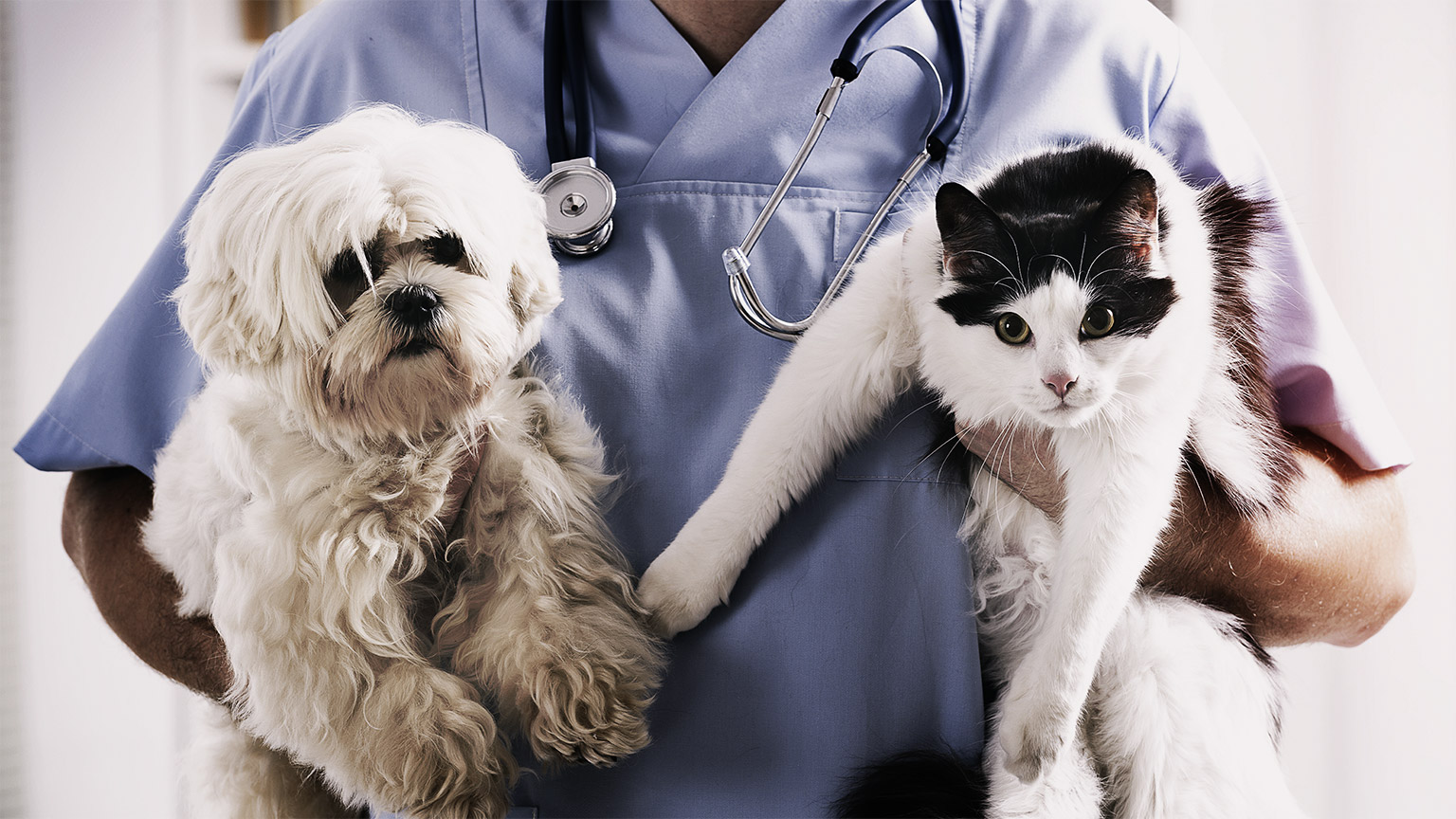Kei runga noa atu! Welcome to Module 5, the last module in this programme. Your hard work is nearly complete, and you’re close to gaining your Level 3 Certificate in Animal Care. Karawhiua!
In this module you will gain introductory knowledge on the general health variations and common diseases/illnesses of companion animals, and how to respond to each individual health condition and disease/illness. Health maintenance, preventative treatments, and planning post treatment routines of companion animals are also an learning important focus. The practical side of the learning will focus on how to perform basic healthcare checks, and how to provide day to day care for animals with health conditions. This is a real ‘hands on’ module!
| Credits | 15 |
| Learning Hours | 150 |
| Learning Outcome | LO5.1 Identify normal health and behaviour of companion animals commonly found in New Zealand LO5.2 Identify and respond to individual health variations of companion animals LO5.3 Describe common diseases/illnesses that affect the health of companion animals in New Zealand |
| Assessment | ANML05A1 |
You are free to plan your studies in the way that works best for you, but we know that guidance on how to do this is also helpful. We suggest the following way to navigate through the learning content over the next few weeks:
| Week 1 |
|
| Week 2 |
|
| Week 3 |
|
| Week 4 |
|
| Week 5 |
|
| Week 6 |
|
| Week 7 |
|
Important
Important Note on your Work Placement and Assessment 05A1
This assessment has a theory part and a practical part. For your practical you will need access to a cat, a dog and one of rabbit, bird or rodent. Please read the assessment immediately so that you can plan where you will complete your practical activities: this could be during your work placement, or it could be with an animal that you have access to.
We recommend that you:
- Download and read assessment 05A1 now
- Talk to your work placement supervisor about planning for the practical part of the assessment
- Talk with the owners of animals that you could potentially work with
In New Zealand, the care of sick pets is governed by the Animal Welfare Act 1999, which sets out the obligations of pet owners to ensure the well-being of their animals. We have referenced this piece of legislation extensively through the programme but if you would like a refresher, review Modules 1 and 2.
The general principles for caring for sick pets based on the Animal Welfare Act include:
- Provision of Proper and Sufficient Food and Water: Pet owners must ensure that their animals have access to adequate and nutritious food and clean water at all times. This is especially important for sick pets, as their dietary needs may change due to their illness.
- Provision of Adequate Shelter: Sick pets must be provided with appropriate shelter that protects them from the elements and allows them to rest and recover comfortably.
- Appropriate Handling: Animals must be handled in a way that does not cause them unnecessary pain or distress. Sick pets may require gentle handling and additional support to avoid making their condition worse.
- Provision of Veterinary Care: Pet owners are required to seek veterinary care for their animals when needed. This includes diagnosing and treating illnesses, injuries, and other health issues. Owners should follow the treatment plan prescribed by the veterinarian.
- Provision of Proper Health Care: This covers regular health checks, vaccinations, parasite control, and other preventative measures to maintain the health of the pet.
- Monitoring and Comfort: Sick pets should be monitored closely for any changes in their condition. They should be kept comfortable and free from pain and suffering, which may include administering medications as prescribed by a veterinarian.
- Hygiene and Cleanliness: Maintaining a clean environment is crucial for the health of sick pets. This includes regular cleaning of their living area, bedding, and feeding utensils to prevent the spread of infection.
- Special Needs for Specific Conditions: Certain illnesses may require specific care, such as isolation from other animals to prevent the spread of contagious diseases, or special feeding techniques for pets that have difficulty eating.
- Humane Euthanasia: If a pet is suffering and there is no reasonable prospect of recovery, owners must consider humane euthanasia to prevent unnecessary suffering, as advised by a veterinarian.
The Ministry for Primary Industries (MPI) oversees animal welfare in New Zealand, and failure to comply with these principles can result in penalties, including fines and imprisonment. These principles aim to ensure that pets are treated with respect and compassion, particularly when they are sick and vulnerable.
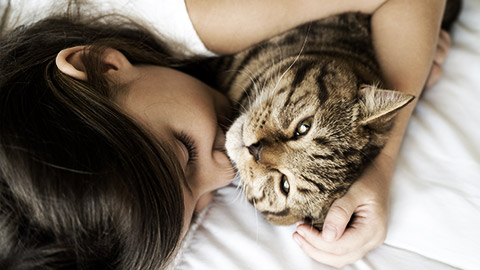
All health care issues can be classified as either infectious or non-infectious. Many health concerns, whether infectious or non-infectious, have preventative treatments.
Infectious disease
All animals are susceptible to infectious disease. Infectious diseases are caused by pathogens such as bacteria, fungi, parasites, and viruses. Infectious disease can spread quickly between different individuals and sometimes even between different species. Diseases that can spread from animals to humans are called zoonotic diseases.
Modes of transmission
A defining characteristic of an infectious disease is that it can be spread from one individual to another. The ways in which the pathogens are spread are called modes of transmission.
- Direct transmission occurs by coming in contact with an infected animal or its blood and other bodily fluids, such as through an infected animal biting or scratching another, touching open wounds or handling faeces.
- Indirect transmission occurs by the infected animal contaminating an object or other animal, which then passes the pathogen to a new host. For example, using non-sterilised surgical equipment and passing a bacterial infection to a new patient.
- Droplet transmission is very common and occurs when pathogens pass out of the infected individual in tiny droplets of water when they cough, sneeze or vocalise.
- Airborne transmission occurs when the pathogens survive after the droplets have dried up. The pathogens remain suspended in the air and are inhaled by another individual. Airborne transmission is relatively rare, and typically only occurs with the tiniest of pathogens – viruses.
- Vector-borne transmission occurs when a different species of animal (the vector) carries the pathogen from the infected individual to a non-infected individual. For example, when a mosquito (the vector in this example) bites an infected animal, it can pass the disease to the next animal it bites. Many vectors are parasitic insects (ATrain Education n.d.).
Hand hygiene and PPE (personal protective equipment) is used to disrupt the transmission of disease. So, it is very important to ensure you follow correct hand hygiene and use PPE appropriately at all times.
We will look at specific infectious diseases in the next topic of this module.
Non-infectious health problems
Non-infectious diseases cannot spread from one individual to another. Non-infectious health problems include:
- Allergies, such as contact allergies, allergies to food and medication, and flea allergy dermatitis (FAD)
- Genetic diseases, such as hip dysplasia in dogs
- Cancers
- Malnutrition due to jaw injury, anorexia or poor diet
- Chemical poisoning, such as bait poisoning in cats and dogs or lead toxicity in birds
- Autoimmune diseases, such as diabetes
- Musculoskeletal conditions or injuries.
Treatment of non-infectious health problems depends on the specific health concern and the animal involved. Some non-infectious diseases, such as diabetes, require ongoing treatment to manage the symptoms and prevent deterioration.

It's important for dog owners in New Zealand to provide regular veterinary care, maintain a healthy diet and exercise regimen, and be vigilant for any signs of illness or discomfort in their pets. Early detection and treatment of health conditions can help ensure a longer and healthier life for dogs.
Dogs in New Zealand, like dogs in many other parts of the world, can experience a range of health conditions. Some common health conditions experienced by dogs in New Zealand include:
Vomiting, Diarrhoea and Constipation
These might be caused by an infection which affects the gastrointestinal tract. Other causes of vomiting, diarrhoea and constipation are eating inappropriate foods or swallowing inappropriate objects, like food wrappings or chocolate. Constipation can be caused by lack of fibre or water in the diet, or lack of exercise.
Symptoms (other than the actual vomit/diarrhoea/constipation) include:
- blood in the vomit or faeces.
- lethargy.
- weight loss.
- fever.
- change in appetite.
Treatment options include:
- withholding food.
- observation.
- rehydration.
- possible medication or surgery depending on the actual diagnosis.
Obesity
Pets are the same as people when it comes to obesity and being obese has negative health effects. Obese dogs have a higher risk of joint pain, liver diseases, and diabetes.
Symptoms of obesity include:
- obvious bulky/heavyset frame.
- not being able to feel the dog's ribs without pressing very hard.
| Very thin | Underweight | Ideal weight | Overweight | Obese |
Treatment options include:
- low-calorie diet or change in diet.
- exercise regimes.
Parvovirus
Otherwise known as Parvo (Canine parvovirus), is a highly infectious virus that attacks the gastrointestinal tract and cardiovascular systems of dogs. The main source of the virus is the faeces of infected dogs. Animals can become infected by ingesting the virus. Subsequently, the virus is then carried to the intestine where it invades the intestinal wall and causes inflammation. Parvovirus is highly contagious and resistant to the effects of heat, detergents, and alcohol so it can remain in the environment for up to a year after an infected dog has been there. This is why the virus can reoccur especially in unvaccinated dogs or in dogs where vaccinations have lapsed. Due to its stability, the virus is easily transmitted via the hair or feet of infected dogs, contaminated shoes, clothes, and other objects. Dogs that become infected with the virus and show clinical signs, will usually become ill within 7-10 days of the initial infection. Young puppies or dogs with other health conditions may die from contracting parvovirus.
Symptoms of parvovirus include:
- severe, bloody diarrhoea (can often be foul smelling).
- loss of appetite and vomiting.
- lethargy
- Fever.
Treatment options include:
- prevention (vaccine) and education is the best option.
- hospital treatment and IV fluids.
- antibiotics and antiemetics.
- quarantine/isolation.
Distemper
Affects the respiratory system, the gastrointestinal system, and the central nervous system. It’s caused by the canine distemper virus.
Symptoms of distemper include:
- Sneezing.
- coughing.
- vomiting.
- diarrhea.
- difficulty breathing.
- fever.
- possible seizures or tremors.
- discharge of mucous from the eyes.
Treatment options include:
- Prevention (vaccine) and education is the best option.
- Supportive care and observation.
- Treatment options are limited as distemper is fatal in 50% of cases and there is no specific cure. Some dogs recover on their own.
Parainfluenza (Viral) and Bordetella (Bacterial) - Kennel Cough
A highly contagious upper respiratory tract disease that causes inflammation of the dog's windpipe. Damage caused by the influenza virus, especially when dogs are young, can leave dogs vulnerable to bacterial infection afterwards. Bordetella bronchiseptica can also infect cats, rabbits, and in rare cases, humans. Both parainfluenza and kennel cough can turn into pneumonia.
Symptoms of kennel cough include:
- dry hacking cough (this may begin to produce phlegm if secondary infection occurs).
- retching.
- breathing difficulties.
- fever.
- nasal discharge.
Treatment options include:
- prevention (vaccine) on an annual basis is the best option.
- medications such as antibiotics can be used to treat the cough.
Ear Infections
Can be a common canine health problem, and it can be caused by allergies, yeast, ear mites, bacteria, hair growth deep in the ear canal, and more.
Symptoms of ear infections include:
- head shaking or head tilting
- redness of the ear canal
- a sore ear that is tender to the touch
- ear discharge
- smelly ear
- scratching at the ear.
Treatment options include:
- antibiotics (for bacterial infections)
- removal of blockage and cleansing (for obstructive infections).
Fleas and Flea Allergy Dermatitis
Blood-sucking parasites, visible to the naked eye. Fleas are a very common external problem for dogs. Some dogs may also develop Flea Allergy Dermatitis (FAD).
Symptoms of fleas and also flea allergy dermatitis include:
- scratching, chewing, or licking of skin
- rubbing skin against objects (like a tree or fence), especially common for FAD
- stained brown fur from licking, especially obvious on white coloured dogs
- hair loss
- rash
- wounds from excessive rubbing, typically on the lower back (near the base of tail), on the thighs, and belly.
Treatment options include:
- oral medications.
- topical solutions.
- Powders.
- medicated shampoos.
Parasitic Infections
Parasites such as ticks and worms are common in dogs. Ticks are small insects that attach themselves to skin and feed on blood. They are found in grassy areas or places with low shrubs. Fortunately, ticks do not have the same health risks in New Zealand as they do in other countries. Eggs of worms are found in soil and grass or in faeces from infected animals. These parasites can cause discomfort, skin irritation, and in some cases, transmit diseases.
Symptoms of parasitic infections include:
- Loose stools and/or diarrhoea.
- Vomiting.
- Weight loss.
- Distended abdomen.
- Visible worms in faeces.
- Respiratory issues.
- Malnutrition and loss of appetite.
- Skin irritation.
- Abscesses.
Treatment options include:
- Medication.
- Regular de-worming.
- Manual removal of the tick.
Skin Conditions
Dogs may experience various skin conditions such as allergies, dermatitis, hot spots, and fungal infections. These conditions can be triggered by environmental factors, food allergies, or parasites such as mites that cause a skin condition called mange.
Symptoms of skin conditions include:
- Scratching, licking or rubbing the irritated areas.
- Redness.
- Flaky/scaly skin.
- Sores or scabs.
- Lumps in the skin.
- Hair loss and bald patches.
Treatment options include:
- Topical medication.
- Medicated shampoos.
- Oral medication.
- Diet changes or food supplements.
- Isolation from the cause of the irritation.
Joint Problems
Joint issues such as arthritis, hip dysplasia, and ligament injuries are common in dogs, particularly as they age. These conditions can cause pain, stiffness, and mobility issues.
Symptoms of joint problems include:
- Limping.
- Swelling around joint areas.
- Slow movements.
- Lack of interest in exercise.
- Loss of appetite.
- Biting or licking the joint.
- Change in mood.
- Sleeping more.
- Not able to climb stairs or jump in the car.
Treatment options include:
- Surgery.
- Change in diet and food supplements.
- Targeted exercise/physiotherapy.
- Anti-inflammatory medication.
- Weight loss.
Dental Problems
Dental issues like periodontal disease, tooth decay, and gum infections are prevalent among dogs. Poor dental hygiene can lead to serious health problems if left untreated.
Symptoms of dental problems include:
- Bad breath.
- Excessive drooling.
- Dropping food while eating.
- Difficulty swallowing.
- Changes in eating habits.
- Not playing with toys.
- Bleeding gums.
- Discolored teeth.
Treatment options include:
- Dental cleaning: at home and regularly by a vet.
- Dental surgery.
- Antibiotics.
- Change in diet.
- Dental chews (toys or hard food designed to remove build up on teether)
Cancer
Cancer can affect dogs of any age and breed. Common types of cancer in dogs include lymphoma, mast cell tumors, and bone cancer. Early detection and treatment are critical for improving the prognosis. Dogs over the age of 10 years are up to 50% more likely to develop cancer.
Symptoms of cancer include:
- Loss of appetite.
- Weight loss.
- Swelling in affected area.
- Tiredness and lack of interest in exercise.
- Changes in urination or defecation.
- Vomiting or diarrhea.
- Limping.
- A bad smell coming from the dog.
Treatment options include:
- Surgery.
- Radiation and chemotherapy.
- Pain relief.
- Change in diet.
Let’s take a moment to let all of that information sink in. Review the information again and then read the following case study.
Case Study
Caleb’s client Milly
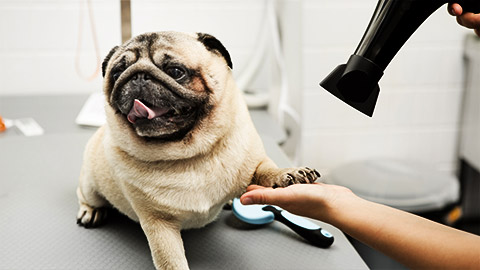
Caleb has been taking care of Milly, a lovable pug, for several months. During her regular grooming session, Caleb noticed that Milly has developed patches of irritated, red skin on her belly and behind her ears. Concerned about her well-being, Caleb gently examined the affected areas and noted that Milly seemed more uncomfortable than usual. He promptly informed Milly's owner about the skin irritation, suggesting they visit a veterinarian to determine the cause and get appropriate treatment.
Activity
It’s not Caleb’s job to diagnose what is wrong with Milly – he did the right thing by recommending that her owner take her to see a vet. However, Caleb is becoming more knowledgeable about the kinds of conditions that dogs have, and he is able to make some good guesses about what might be wrong with Milly. What do you think could be the issue? Refer to the learning content above and share your thoughts in the forum.

It's essential for cat owners in New Zealand to provide regular veterinary care, including vaccinations, parasite prevention, and wellness exams, to ensure their cats remain healthy and happy. Additionally, maintaining a balanced diet, providing environmental enrichment, and minimizing stressors can help prevent many health problems in cats.
Lower Urinary Tract Disease
Feline lower urinary tract disease (FLUTD) can be fatal to cats and covers several conditions that affect a cat’s bladder.
Symptoms of lower urinary tract disease include:
- not using a litter box (or urinating inside on the floor)
- straining without producing any urine
- blood in the urine (extreme cases).
Treatment options include:
- IV fluids
- insertion of a urinary catheter
- pain medication
- medication to relieve swelling and spasms
- special diets.
Cat Flu
Feline respiratory disease or cat flu (Feline calicivirus) is a highly contagious upper respiratory infection. Transmission is via respiratory discharges, primarily sneezing. Possible causes may include feline calicivirus, feline herpes virus, rhinotracheitis.
Symptoms of cat flu include:
- conjunctivitis
- oral ulcers
- fever
- gingivitis
- miscarriage in pregnant cats
- sneezing
- nasal discharge
- ocular discharge.
Treatment options include:
- prevention (vaccine) is the best option
- isolation
- anti-viral medication
- eye drops
- antibiotics (to treat any secondary bacterial infection).
Cancer
The two most common types of cancers are Lymphosarcoma (a cancer of the intestine or chest) or squamous cell carcinoma (abnormal growths on the skin).
Symptoms of cancer include:
- lumps, swelling, and sores
- lethargy
- weight loss
- difficulty breathing
- vomiting
- difficulty urinating and defecating.
Treatment options are often limited but may include:
- chemotherapy
- surgery
- radiation
- immunotherapy.
Fleas
Blood-sucking parasites, visible to the naked eye. Fleas are a very common external problem for cats, especially in warmer months.
Symptoms of fleas include:
- scratching or licking
- hair loss
- skin infections
- flea dirt on the skin.
Treatment options include:
- oral medications
- topical solutions
- powders.
Kidney Disease
Kidney problems reduce a cat's ability to excrete waste, which causes a build-up of dangerous toxins in the bloodstream. It can be caused by several factors, such as high blood pressure, infections, kidney stones, cancer, and old age.
Symptoms of kidney disease include:
- decreased appetite
- weight loss
- vomiting
- diarrhoea
- lethargy.
Treatment options include:
- surgery to remove blockages
- IV fluids
- special diets
- medication.
Feline Immunodeficiency Virus (FIV)
A virus that depletes the number of white blood cells and eventually makes the cat less able to fight off infection. It is a very slow-acting virus, therefore many cats with FIV enjoy a normal lifespan with no apparent problems. The virus is usually transmitted through a deep penetrating bite (FIV cat to non-FIV cat) where the virus (in the saliva) is injected directly into the bloodstream. Bites of this kind are rare and normally only occur in free-roaming, unneutered tomcats. This is a species-specific virus and cannot be transmitted to humans.
Feline Leukemia (FeLV)
A virus (Panleukopenia) that ultimately compromises a cat's immune system, however, it is much more serious than FIV.
Felines that have been diagnosed with this disease, can transmit it to other felines through a range of routes including through faecal-oral, direct contact with faeces from litter trays, and shared water, and food bowls. In addition, the disease is can be transmitted via contaminated surfaces from urine or vomit along with humans that have virus contaminants on their clothing or shoes. The virus is exceptionally durable and can last up to a year on surfaces if they are not cleaned properly. Any area that has been contaminated with this virus must be cleaned with bleach as this is the only substance that can completely remove it. If a cat has been diagnosed with this virus, they will need to be isolated immediately and any area that it has been in contact with has been thoroughly cleaned to avoid the transmission to other cats.
Symptoms of FeLV include:
- tumours in the chest, bowel, lymph nodes, kidney, liver, spleen, or bone marrow
- anaemia
- infertility
- miscarriage
- various infections.
Treatment options are limited as there is no cure for FeLV, they include:
- keep the cat indoors (to reduce exposure to infection)
- neuter the cat (to limit the escape/roaming instinct)
- treat secondary infections as they occur
- if cancer develops, cats can receive chemotherapy
- vaccination while still a kitten.
Abscesses
Lump full of infection that may or may not have burst. Often caused by cats fighting and/or being attacked by a predator.
Symptoms of abscesses include:
- lump that may or may not have burst open
- loss of appetite
- sensitivity to being touched or picked up.
Treatment options include:
- antibiotics
- surgical draining of accumulated pus
- use of a head collar to prevent self-grooming
- containment indoors.
Internal and external parasites:
Cats in New Zealand can be affected by internal parasites such as roundworms, hookworms, and tapeworms. Regular deworming is essential to prevent infestations. External parasites such as ticks can cause irritation, skin problems, and transmit diseases.
Symptoms of internal parasites include:
- Gastrointestinal issues
- Weight loss
- Lethargy
- Poor coat condition
- Pot-bellied appearance
- Visible worms in feces or vomit
- Anal itching or scooting
- Anemia
- Coughing or respiratory symptoms
- Visible signs of irritation
Symptoms of external parasites include:
- Irritation and redness around the site of the tick bite.
- Anaemia in young cats with lots of ticks.
Treatment options include:
- Medication.
- Regular de-worming.
- Manual removal of the tick.
Tooth and gum disease
Dental problems are prevalent in cats, including tartar buildup, gingivitis, and periodontal disease. Regular dental care and veterinary check-ups are crucial for maintaining oral health.
Symptoms of tooth and gum disease include:
- A suddenly ‘picky’ appetite.
- pawing at the mouth.
- head shaking or jaw chattering.
- Chewing with obvious discomfort.
- Dropping food while eating.
- swallowing with difficulty.
- Drooling excessively.
- Saliva containing blood.
- Halitosis (bad breath).
Treatment options include:
- Scaling and cleaning of teeth
- Anti-inflammatory medications
- Antibiotics
- Dental diets and dental chew toys
- Brushing teeth regularly with a pet tooth brush
- Water additives or dental gel
Obesity
Like in many other countries, obesity is a significant issue among cats in New Zealand. It can lead to various health problems such as diabetes, arthritis, and heart disease.
Symptoms of obesity include:
- Loss of a visible waistline
- Rib or hip bones cannot be felt under the skin
- Rectangular body shape
- Lack of interest in exercise or moving around
- Fur looks greasy and matted due to inability to lick
| Very thin | Underweight | Ideal weight | Overweight | Obese |
Treatment options include:
- Proper diet
- Limiting or removing treat foods
- Enrichment activities to avoid boredom feeding
- Play time to encourage movement and exercise
- Regular checkups for metabolic issues that cause obesity
Allergies
Cats can develop allergies to various substances, including pollen, dust mites, and certain foods.
Symptoms of allergies include:
- Sneezing, coughing, and wheezing
- Itchy, running eyes
- Ear infections
- Vomiting or diarrhea
- Snoring
- Swollen, sensitive paws
- Excessive licking (grooming) leading to balding areas of fur
- Red or dry skin
- Scratching
Treatment options include:
- Use flea and tick control
- Use anti-allergy cat litter
- Bathe your cat to relieve itching and remove irritants
- Keep your home clean of dirt and dust
- Wash cat bedding regularly
- Provide a healthy diet
- Avoid smoking around pets
Now that we have looked at some of the common health issues that affect cats, you’re ready to test your knowledge. Read the following case study.
Case Study
Bernadette has bad breath!

Aroha is approached by a customer who introduces himself as Donald and explains that his cat Bernadette has really bad breath. He says that he tried giving her chicken necks he purchased from the supermarket, but Bernadette won’t touch them. He wants to know what dental products are available to help clear up Bernadette’s bad breath issue.
While Aroha walks him to the part of the shop where the cat products are, she asks Donald if he has asked Bernadette’s vet about her bad breath. Donald responds that Bernadette hasn’t been to the vet for a while because Bernadette gets very stressed there. Aroha is a little worried when she hears this because poor dental health is not the only reason cats can have bad breath. She gently suggests to Donald that a general health checkup might be a good idea for Bernadette.
There’s a common health condition that Aroha is worried might be contributing to Bernadette’s bad breath over and above poor dental health. Review the common health conditions for cats and see if you can spot it. When you think you know, check to see if your guess was correct. Click the + button to reveal the answer.
Aroha is thinking about one of the strains of cat flu. Gingivitis, which can cause bad breath is one of the symptoms of cat flu. Most cats recover from cat flu, but it can cause ongoing issues like gingivitis which can be difficult to treat. It’s best to see a vet about this.
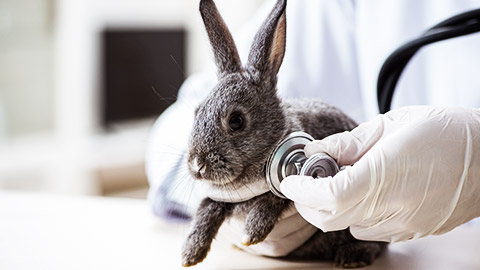
Rabbit owners need to be aware that rabbits are very good at hiding when they are unwell, which is a survival strategy to prevent them from becoming easy prey. It sometimes seems that like their health can go downhill very rapidly and that a pet that seemed fine in the morning is now very unwell in the evening.
It is a good idea to find a vet who has experience working with rabbits, due to their specific health needs. As with our other companion animals, regular veterinary check-ups, a balanced diet, a clean living environment, and plenty of exercise can help prevent many of the health issues in domestic rabbits.
Gastrointestinal Stasis
Also known as GI stasis, this condition occurs when a rabbit's digestive system slows down or stops completely. It can be caused by stress, poor diet, lack of exercise, or dental problems. If you notice any of these symptoms in your rabbit, it's crucial to seek veterinary attention promptly. GI stasis can quickly become life-threatening if left untreated, so early intervention is essential for a better outcome.
Symptoms of GI Stasis include:
- Decreased or lack of appetite
- Lethargy or lack of energy
- Abdominal discomfort
- Weight loss
- Decreased water intake
- Gastrointestinal noises
- Straining or difficulty when passing faeces or lack of faeces altogether
- Flatulence
Treatment options include:
- Fluid Therapy
- Gastrointestinal motility drugs
- Pain management
- Feeding support
- Environmental management
- Dental care
- Addressing underlying causes
- Monitoring and follow-up care
Dental Problems
Rabbits' teeth grow continuously, and if they don't wear down properly, it can lead to dental issues such as overgrown teeth, abscesses, or malocclusion.
Symptoms of dental problems include:
- Reduced or loss of appetite
- Selective eating
- Weight loss
- Drooling or salivation
- Changes in eating behavior
- Facial swelling or abscesses
- Inflamed or bleeding gums
- Facial tilting or head tilt
- Eye discharge or eye problems
- Behavioral changes
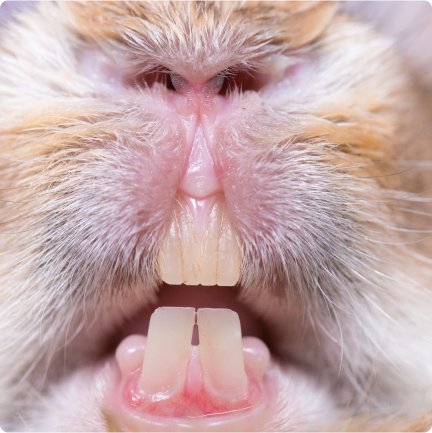 |
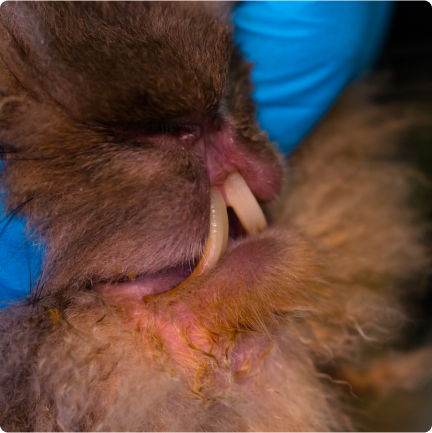 |
| Healthy teeth | Maloccluded teeth |
Treatment options include:
- Trimming or filing
- Extraction
- Antibiotics
- Pain management
- Dietary changes
- Environmental modifications
- Regular monitoring and follow-up
Respiratory Infections
Rabbits are susceptible to respiratory infections, especially if they're housed in damp or dirty conditions.
Symptoms of respiratory infections include:
- Nasal discharge
- Sneezing
- Nasal congestion
- Difficulty breathing
- Coughing
- Eye discharge
- Lethargy/loss of energy
- Loss of appetite
- Weight loss
- Fever
- Head tilt
Treatment options include:
- Antibiotics
- Anti-inflammatory medications
- Bronchodilators to open the airways
- Nebulization
- Fluid therapy
- Humidification
- Isolation and quarantine
- Environmental management
- Nutritional support
- Regular monitoring and veterinary follow-up
Ear Infections
Rabbits can develop infections in their ears, particularly if they're not kept clean.
Symptoms of ear infections include:
- Head Tilting
- Scratching or Rubbing at the Ear
- Head Shaking
- Ear Discharge
- Swelling or Redness
- Pain or Sensitivity
- Loss of Balance or Coordination
- Reduced Appetite or Activity
- Tilting or Rotating While Moving
Treatments options include:
- Antibiotics
- Anti-inflammatories (for pain and reducing swelling)
- Saline solution ear flushes
- Surgery for severe infections
Other conditions affecting rabbits
- Pododermatitis: Also known as sore hocks, this condition occurs when a rabbit's hocks become inflamed due to prolonged pressure on the feet, often from sitting on wire flooring.
- Parasites: Rabbits can be infested with external parasites such as fleas, mites, or ticks, as well as internal parasites like worms. Treatment is similar to that in cats and dogs.
- Obesity: Overfeeding and lack of exercise can lead to obesity in rabbits, which can contribute to various health problems. Changing the diet and getting more exercise will prevent this.
- Uterine Tumors: Female rabbits that have not been spayed are at risk of developing uterine tumors, which are common and can be life-threatening.
- Flystrike: Flies laying eggs on a rabbit's skin can lead to flystrike, a condition where the hatched maggots feed on the rabbit's flesh, causing serious damage. Regular cleaning of the rabbit's habitat will help prevent this.
- Heat Stroke: Rabbits are sensitive to heat and can suffer from heat stroke if they're exposed to high temperatures without access to shade or cool water.
Check out the following case study about one of Kai’s rabbits. See if you can work out a solution to the problem.
Case Study
Ravenna’s sore hocks
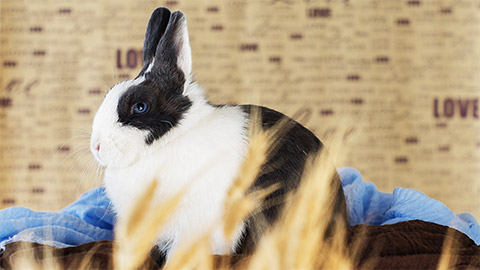
Kai has noticed that Ravenna isn’t her usual self. She lacks energy and has become a little bit aggressive when Kai tries to pick her up. Watching her one evening, Kai sees a red, sore patch on one of her back legs and realizes that she has a sore hock. Ravenna and Freya have free access to Kai’s house during the day, and their night cage has the recommended flooring for rabbits. Kai wonders whether it is the hard flooring in the kitchen that has been rubbing on Ravenna’s foot.
Activity
Research online and make notes for your own reference: what should Kai do to:
- Heal Ravenna’s sore hock?
- Prevent either Ravenna or Freya from getting sore hocks in the future?
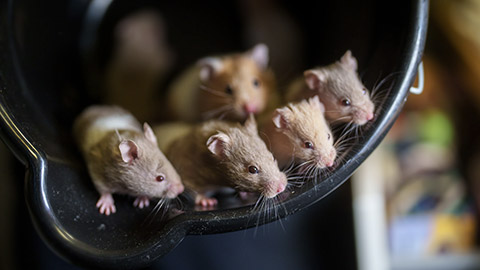
Common health conditions of mice
It may surprise you that mice, despite their small and delicate looking bodies, are surprisingly resilient when it comes to their health. However, like all other companion animals there are some conditions that their human owners to need to be aware of and watch out for. According to the SPCA, mice can get sick very quickly and they “often only show subtle signs of being in pain or distress or that they are suffering, until it is very severe.” (Advice & welfare: Caring for mice • SPCA New Zealand 2024)
General signs of poor health in mice include:
- Not eating or drinking
- Lack of energy
- Diarrhoea
- Dull coat or hair loss
- Discharge from eyes/dull eye colour
- Discharge from nostrils
- Abnormal breathing
- Weak hind legs
- Scratching excessively
- Weight loss
- Injuries
- New lumps or bumps
Malocclusion
Mice have one pair of upper and lower incisors at the front of their mouth which they use to grip and bite their food. Malocclusion is the misalignment of the incisors present in mice whose upper (maxilla) and lower (mandible) jaws do not properly align. Malocclusion can be diagnosed with a simple oral exam. It can make eating their food difficult which may result in starvation and poor growth.
Symptoms of malocclusion include:
- visible overgrowth or uneven growth of incisors
- excess salivation
- rubbing at the mouth with feet
- foul odour from the mouth
- inability to chew hard food
- weight loss
- sores developing in or near the mouth.
Treatment options include:
- tooth trimming
- powdered diet to reduce the need for chewing.
Tumours (Including Cancerous)
Quite a common problem in mice. Tumours in younger mice may turn out to be abscesses, which are non-cancerous.
Symptoms of tumours include:
- discomfort
- restrictions to normal movement
- lethargy
- obvious protrusions.
Treatment options include:
- non-cancerous tumours can be surgically removed or treated with antibiotics
- chemotherapeutic medications to stop the spreading of malignant tumours
- a variety of trial medicines and vaccines are being researched (laboratory mice).
Ear Infections
Mice with ear infections may begin to circle and in severe cases fall to one side when trying to move around their enclosure. Ear infections are extremely painful and cause severe discomfort to mice.
Symptoms of ear infections include:
- difficulty hearing
- red discharge from the eyes
- sneezing
- difficulty breathing
- scratching the ears
- seizures
- lethargy and depression.
Treatment options include:
- antibiotics may treat clinical signs
- wax removal
- rupture of the ear drum (must be done under anesthesia)
- anti-inflammatory medications.
Respiratory Illnesses
As with other animals these are caused by viruses and bacteria in mice.
Symptoms include:
- sneezing
- difficulty breathing
- noisy breathing.
Treatment options include:
- Antibiotics
- Anti-inflammatory medications
- Bronchodilators to open the airways
- Nebulization
- Fluid therapy
- Humidification
- Isolation and quarantine
- Environmental management
- Nutritional support
- Regular monitoring and veterinary follow-up
Bowel Diseases
There are a range of bowel problems in mice, mostly due to diet. This can include inappropriate food, inappropriate food hygiene, and contaminated food.
Symptoms include:
- Diarrhea
- Soft, mushy faeces
- Faeces stuck to the fur around the anus
Treatment options include:
- Medication including antibiotics and anti-inflammatory drugs
- Change of diet
- Change in hygiene practices around food given to mice
Skin diseases
These can come from allergies or from fungal infections, parasites or mites living on the skin.
Symptoms include:
- Flaking and balding patches on the skin
- Redness of skin
- Itching
- Scabs from scratching
Treatment options include:
- Avoiding environmental irritants
- Antibiotics
- Topical skin medications
- Supplementary dietary vitamins
Common health conditions of rats
The types of health issues that are common to pet rats are similar to those in pet mice. Signs of disease or pain can be difficult for humans to spot until the animal is very unwell.
General signs of poor health in rats are the same as mice and include:
- Not eating or drinking
- Lack of energy
- Diarrhoea
- Dull coat or hair loss
- Discharge from eyes/dull eye colour
- Discharge from nostrils
- Abnormal breathing
- Weak hind legs
- Scratching excessively
- Weight loss
- Injuries
- New lumps or bumps
As mice and rats share the same common health conditions, we won’t be repeating the common symptoms and treatments here. You may refer to the section on mice.
Common health conditions of Guinea pigs
Health problems among guinea pigs are usually related to aging, dental issues, reproductive disorders, injury, or inappropriate care. Infectious diseases usually occur only in guinea pigs that live with other guinea pigs. Intestinal parasites are not common. Tumors are rare in young guinea pigs but are more common in guinea pigs that are more than 5 years old. The conditions that most commonly affect them are similar to mice and rats.
An important difference between guinea pigs and our other pocket pets is that they are very sensitive to antibiotics, which can make treating sick guinea pigs very difficult.
Common health issues include:
- Malocclusion
- Ear infections
- Bowel diseases
- Respiratory illnesses
- Skin diseases
The symptoms and treatments will be similar to those for mice and rats except that antibiotics are not recommended.
Vitamin C Deficiency (Scurvy)
Guinea pigs can’t make their own vitamin C (just like humans) and must obtain it from their diet.
Symptoms of Vitamin C Deficiency include:
- problems walking/limping
- swollen joints
- bleeding under the skin and internal bleeding
- weakness and lack energy
- rough and dull fur
- loss of appetite
- weight loss
- diarrhea
Treatment options include:
- change in diet
- Vit C supplements or injections (given by a vet)
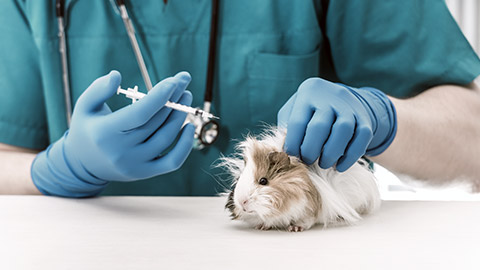
Other conditions affecting Guinea pigs
- Pododermatitis: This condition occurs when guinea pig footpads become inflamed and infected due to prolonged pressure on the feet, often from sitting on wire flooring or other unsuitable flooring in their cages.
- Obesity: Overfeeding and lack of exercise can lead to obesity in guinea pigs, which can contribute to various health problems.
- Heat Stroke: Guinea pigs are sensitive to heat and can suffer from heat stroke if they're exposed to high temperatures without access to shade or cool water.
- Hardening of the Organs (Metastatic Calcification): excess calcium in the body can cause the internal organs to harden. This may be caused by an unsuitable diet. Guinea pigs with this condition often don’t show signs of disease and will die suddenly.
- Ileus: this is a build of gas in the intestinal system and is often caused by another health condition. Guinea pigs eat constantly and should therefore be passing urine and faeces regularly. If this is not happening, ileus can occur due to food not pushing the gas out. It can cause pain and can be stressful enough to cause death.
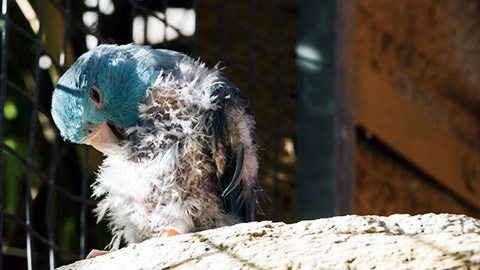
Companion birds are no different to our four-legged mammal companion animals: they need regular health checkups to help them live long and happy lives.
External Parasites
Mites and lice are the most common external parasites that affect birds. They are often spread in group aviaries or from wild birds that are allowed near caged birds. They are not transferable to humans.
Symptoms of external parasites include:
- itchiness
- feather loss
- skin lesions.
Treatment options include:
- mite and lice spray
- quarantining new birds for a few days before introducing them to the larger group.
Internal Parasites
Worms, such as roundworm, tapeworm, flukes, and protozoa can infect birds but are fortunately quite rare.
Symptoms of internal parasites include:
- decreased appetite
- weight loss
- lethargy
- sitting fluffed up
- abnormal droppings.
Treatment options include:
- worming drops added to the water supply
- antibiotics (for certain infestations).
Nutrient Deficiencies
Birds that eat a diet mainly of seeds can develop Vitamin A deficiency. Birds can also develop deficiencies in Iodine, Calcium, Phosphorus, and Vitamin D.
Symptoms of nutrient deficiencies include:
- lesions on the mouth, eyes, nose (Vitamin A)
- nasal discharge, sneezing, conjunctivitis, eye swelling (Vitamin A)
- poor feather quality (Vitamin A)
- decreased appetite (Vitamin A)
- weakness (Vitamin D, Calcium, and Phosphorus)
- fractures (Vitamin D, Calcium, and Phosphorus)
- poor egg quality (Vitamin D, Calcium, and Phosphorus).
Treatment options include:
- supplemented diets
- direct exposure to sunlight (Vitamin D and Calcium).
Obesity
Birds fed a high-seed diet are often obese, particularly if there are a lot of sunflower seeds in the diet.
Symptoms are hard to detect because of their feathered coat, but one technique you can try is:
- Feel for the keel bone, which is the bony ridge that divides the two breast muscles.
- The bone should feel present with not too much flesh covering it from either side, but also not too prominent or ridge-like.
Treatment options include changes to diet.
Beak and Feather Disease
Can affect almost all species of birds but is quite common among cockatoos. It is a contagious virus spread via contact with shed feathers.
Symptoms of beak and feather disease include:
- weak feathers
- loss of feathers
- suppressed immune system
- general illness.
There is no direct treatment, prevention options include:
- limiting contact with wild birds
- maintaining good cage hygiene
- dust control.
Yeast Infections
Species of yeast that can affect birds include candida, aspergillus, cryptococcus, and Malassezia.
Symptoms of yeast infections include:
- weight loss
- vomiting
- diarrhoea
- lethargy
- sneezing and breathing issues.
Treatment options are quite lengthy and invasive, so prevention is better. These include:
- maintaining a strong immune system with high-quality feed and effective hygiene routines
- reducing stress.
Summary
Wow, that was a lot of information to cover! Ka pai on getting through it all. We’ve looked at the common health conditions that our companion animals might face, and what the typical treatments are for them. Before moving onto Topic 2, let’s take a moment to review our learning. Select the best answer for each question. Only one option will be correct.
